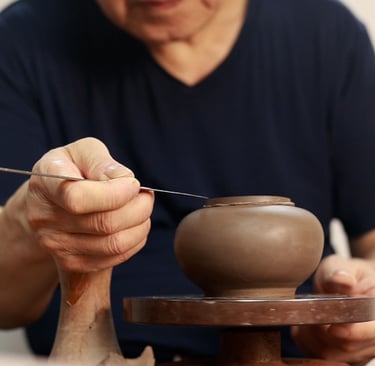What Challenges Are Facing the Yixing Teapot Today
Challenges facing the Yixing teapot today include industrialization, loss of traditional craftsmanship, authenticity concerns, and a lack of cultural awareness. Addressing these issues is crucial to preserving its artistic and cultural legacy.
YIXING TEAPOTS
Let’s face it: when you think of a Yixing teapot, you probably picture something ancient, beautiful, and deeply tied to Chinese culture. But here's the thing—while these teapots are known for their craftsmanship and history, they’re facing some serious challenges today. What happened to the fine art of making them? Why are these teapots, once celebrated for their uniqueness, now at risk of being mass-produced?
Let’s break it down and explore why the Yixing teapot is at a crossroads in its journey through time.
Challenges for the Yixing Teapot
Impact of Industrialization on Craftsmanship
One of the biggest problems we’re dealing with right now is industrialization. You know what it’s like when demand skyrockets, and businesses start rushing to produce more at a faster rate. Well, that's exactly what’s happening with Yixing teapots. Many artisans are opting for a more mechanized approach to meet the growing demand, and in doing so, they’re sacrificing the intricate craftsmanship that made these teapots so special.
These mass-produced versions lack the artistic touch of the original teapots. What used to be an art form is now turning into just another product. There’s no soul in the creation, and that’s a huge problem. The beauty of the Yixing teapot lies in the artistry, and when that’s lost, it’s just not the same.
Disconnection from Traditional Values
Here’s another issue: the disconnect from traditional values. In the past, the teapot was more than just a piece of pottery—it had cultural depth, philosophical meaning, and was often created with input from the scholarly elite. These scholars were the patrons and motivators for Yixing craftsmanship. They were the ones who infused teapots with cultural stories and meanings.
Today, that tradition is fading. There’s no longer a strong presence of those cultural influencers, and modern artisans often miss out on the rich philosophical context that once shaped their craft. As a result, the teapots being made today might not carry the same spiritual and artistic weight as their predecessors.
Issues of Authenticity
Let’s talk about authenticity. In a world driven by profit, it’s no surprise that counterfeit teapots are flooding the market. Fake Yixing teapots are often made from cheaper materials and marketed as the real deal. Some sellers even use chemical clays to imitate the traditional ones, fooling buyers into thinking they’re getting an authentic product.
Here’s the problem: this hurts the integrity of the craft. It confuses customers and threatens the authenticity of Yixing teapots as a whole. Genuine craftsmanship is being overshadowed by cheap knock-offs, and that’s not something we can just ignore. If we’re not careful, these fakes could completely tarnish the reputation of Yixing teapots.
Lack of Cultural Awareness
Another issue at play is a lack of cultural awareness. The Yixing teapot has a deep-rooted history that goes beyond just being a decorative piece. Yet, today, a lot of people don’t understand the significance of these teapots or the culture behind them. They’re seen as pretty objects rather than valuable cultural artifacts.
This disconnect between modern society and the ancient art of Yixing teapots is a serious problem. If we don’t raise awareness and educate people about the history, techniques, and significance of these teapots, the craft could fade into obscurity.
Conclusion
So, where does that leave us? The Yixing teapot is at risk. Industrialization, a lack of traditional values, counterfeit products, and a general lack of understanding about its cultural importance are all factors that threaten this art form. Purchasing authentic Yixing teapots is one meaningful way to support the artisans behind this timeless craft.
But here’s the thing: it doesn’t have to be this way. If we can foster a deeper appreciation for the history and artistry behind these teapots, we can help preserve them for future generations. Let’s keep the Yixing teapot alive—not just as a craft, but as a piece of cultural heritage.
If we don’t, we risk losing something truly remarkable.
FAQs
1. What makes the Yixing teapot unique?
The Yixing teapot is known for its natural clay material, often sourced from the Yixing region in China. Its craftsmanship, coupled with its cultural and historical significance, sets it apart from other teapots.
2. Why is industrialization bad for Yixing teapots?
Industrialization has led to mass production of Yixing teapots, which compromises the intricate craftsmanship that makes them so special. The process is streamlined to meet demand, but the artistry is lost.
3. How can I tell if my Yixing teapot is authentic?
Look for signs such as the texture and colour of the clay. Real Yixing teapots are made from natural clay and have a unique, hand-crafted finish. Be cautious of overly shiny or perfectly symmetrical designs.
4. What is the cultural significance of the Yixing teapot?
The Yixing teapot has a rich history rooted in Chinese culture, often associated with scholars and intellectuals. It’s not just a teapot, but a symbol of art, philosophy, and tradition.


